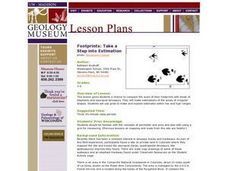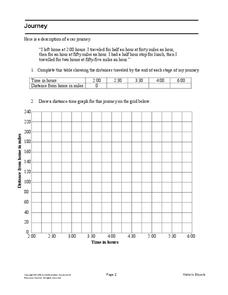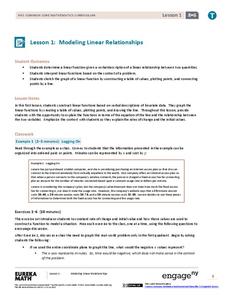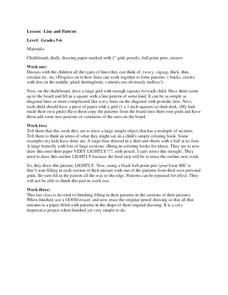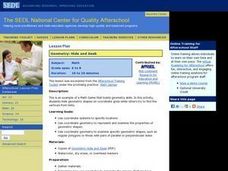Curated OER
Footprints: Take a Step into Estimation
Compare sizes of student footprints with those of elephants and sauropod dinosaurs! Upper graders make estimations of the areas of irregular shapes; students use grids to make and explain estimates within low and high ranges.
Curated OER
If you have to find the area of a region, how would you calculate it?
Fifth graders find the area of rice farms. In this area lesson, 5th graders draw shapes and grid them to find the area. They compare different rice fields to see which one takes up more space and has the larger area.
Curated OER
Real World Investigation- Math and Geography- Elevation Changes
In this math and geography real world investigation, 6th graders plan a driving trip to a city that is located several states away from their home while recording the elevations of three cities that are included in the trip. They use...
Curated OER
Absolute and Relative Location
Second graders understand the difference between relative and absolute location using the grid map as an example of an absolute location. They observe a class map showing longitude and latitude lines and learn that they provide exact...
Mathematics Assessment Project
Generalizing Patterns: Table Tiles
As part of a study of geometric patterns, scholars complete an assessment task determining the number of tiles needed to cover a tabletop. They then evaluate provided sample responses to see different ways to solve the same problems.
Mathematics Assessment Project
Journey
Drive home math concepts with an engaging task. Learners follow a verbal description to fill in a table and create a distance-time graph representing a car journey. They then answer questions by interpreting the graph.
EngageNY
Modeling Linear Relationships
Math modeling is made easy with the first installment of a 16-part module that teaches pupils to model real-world situations as linear relationships. They create graphs, tables of values, and equations given verbal descriptions.
Curated OER
Be an Artist
In this visual arts worksheet, 3rd graders will use a grid to recreate a given image. Using similar line segments in each box of the grid, students will recreate the image of a fish in the boxes provided.
Curated OER
Be an Artist: Frog
In this visual arts worksheet, young scholars will use a grid to recreate a given image. Using similar line segments in each box of the grid, students will recreate the image of a frog in the boxes provided.
Curated OER
Be an Artist: Lobster
For this visual arts worksheet, students will use a grid to recreate a given image. Using similar line segments in each box of the grid, students will recreate the image of a lobster in the boxes provided.
Curated OER
Be an Artist: Dragonfly
In this visual arts worksheet, students will use a grid to recreate a given image. Using similar line segments in each box of the grid, students will recreate the image of a dragonfly in the boxes provided.
Curated OER
Be an Artist: Bighorn Sheep
In this visual arts worksheet, students will use a grid to recreate a given image. Using similar line segments in each box of the grid, students will recreate the image of a bighorn sheep in the boxes provided.
Curated OER
Be an Artist: Softshell Turtle
In this visual arts worksheet, students will use a grid to recreate a given image. Using similar line segments in each box of the grid, students will recreate the image of a softshell turtle in the boxes provided.
Curated OER
Be an Artist: Hermit Crab
In this visual arts worksheet, students will use a grid to recreate a given image. Using similar line segments in each box of the grid, students will recreate the image of a hermit crab in the boxes provided.
Curated OER
Line and Pattern
Students investigate lines and patterns. In this line and pattern instructional activity, students discuss types of lines and work on grids. They draw a picture very lightly before filling it in with the pattern they made in the grid.
Curated OER
Designing the Toy Planet Store
Sixth graders create a grid of their fictitious store. In this measurement lesson, 6th graders use a computer to measure out the floor of their store and create furniture, doorways, windows, and more. This lesson includes directions for...
Curated OER
Graphing Integers
Fifth graders complete an integer graphing activity. In this integer graphing lesson, 5th graders use coordinate grids to help them complete linear functions and integer graphing.
Curated OER
Multo - game (all, Mathematics)
Third graders practice multiplication using a fun game called "Multo." They write numbers in boxes using a grid similar to one found on a Bingo card. They score when their numbers are called. The smallest number possible is zero and the...
Curated OER
Grammar Bingo
Students review the rules of grammar. They create their own grid and fill it in with given grammatical principles. Students use their grid for a bingo card and play grammar bingo. Students read their notes and verify them for accuracy...
Curated OER
Circular "Mandala"
Students create a nonobjective design from a magazine photo (or personal photograph) using a view finder. By using colored pencils the drawing use layers to recreate the colors in the magazine picture.
Curated OER
Relations and Graphs
Here is a simple, yet clever lesson on how to teach the important concepts of greater than, less than, and equal to. Pupils write their names down on grid paper - one letter per box. They compare their names and find a name that is...
PBS
Geometry: Hide and Seek
A geometry game that resembles Battleship is the foundation for hide and seek where "hiders" draw shapes on coordinate planes and "seekers" must guess the shape and its location based on questions and clues. Reproducible, paper-sized...
Curated OER
Tenths and Hundredths - Reteach 21.1
Learners review explanations and models, use grid paper to draw models to show fractions and decimals, and convert them. Pupils solve sixteen problems.
Mathematics Vision Project
Module 6: Congruence, Construction, and Proof
Trace the links between a variety of math concepts in this far-reaching unit. Ideas that seem very different on the outset (like the distance formula and rigid transformations) come together in very natural and logical ways. This unit...


